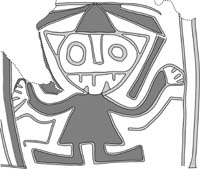IN 2003 RESEARCHERS in Peru’s Patavilca River Valley uncovered a 4,000 year-old-gourd fragment that appears to be the oldest identifiable religious icon in the Americas. The fragment bears the image of the Staff God, which was the main religious figure in South America until the Europeans arrived in 1532. Radiocarbon dating of the gourd to 2250 B.C. suggests that organized religion began in the Americas some 1,000 years earlier than previously determined.
Members of the Proyecto Arqueológico Norte Chico — Jonathan Haas of The Field Museum in Chicago, Winifred Creamer of Northern Illinois University, and Peruvian archaeologist Alvaro Ruiz — discovered the icon while they were collecting artifacts at a looted burial ground along the coast of Peru.

“We did some surface collection and found this gourd fragment,” Haas said. “We looked at it and everybody’s jaw dropped and we said, ‘This has all the characteristics of the Staff God.’ ”
The drawing’s simplicity hinted at its age, and radiocarbon dating proved that this was the oldest image of the Staff God any researcher has uncovered so far. The team found a similar image also painted on a gourd at a nearby cemetery.
Worshiped as the creator, the Staff God appears in temples and artifacts throughout Andean cultures spanning thousands of years. The Staff God is recognizable by its fangs, splayed feet, and snake iconography. It is usually drawn with a staff in one or both of its hands and with snakes on a belt, on its hands, or coming out of its head.
The icon Haas and his team found has splayed feet, a fanged mouth, and holds a staff. The left hand is curved in the form of a snake.
“The Staff God undergoes change and evolution over the course of 2,000 to 3,000 years. It emerges during the Inca time as the Creator God,” Haas explained.

Haas and his colleagues were working 120 miles north of Lima in the Norte Chico region of the Peruvian Coast. The region’s four coastal valleys were densely populated between 2600 B.C. and 2000 B.C.
“To date, 26 major centers have been recorded in the Norte Chico region, all with monumental architecture, large-scale ceremonial structures, and complex residential and administrative architecture,” Winifred Creamer said. “It is a truly unique concentration of settlements anywhere in the Americas.”
In 2001, Creamer and Haas’ research team determined that around 2600 B.C. ancient Peruvians were building a complex city with pyramids at around the same time as the ancient Egyptians built their cities and pyramids.
Haas suggests that the Norte Chico region is the cradle of Andean civilization. The area would eventually give rise to the Inca empire, who during the height of their reign in the 1500s, ruled the largest empire on Earth.
The 2003 artifact pushes back the starting point for Andean religion and civilization and shows the Staff God at its most basic representation.
“What we’re seeing with Andean religion is although it has many different forms throughout its lifetime, it has a central core to it and that central core is arising in the 3rd millennium B.C.,” Haas said.
Published in Americas Americas magazine, July-August 2003, by Chris Hardman
